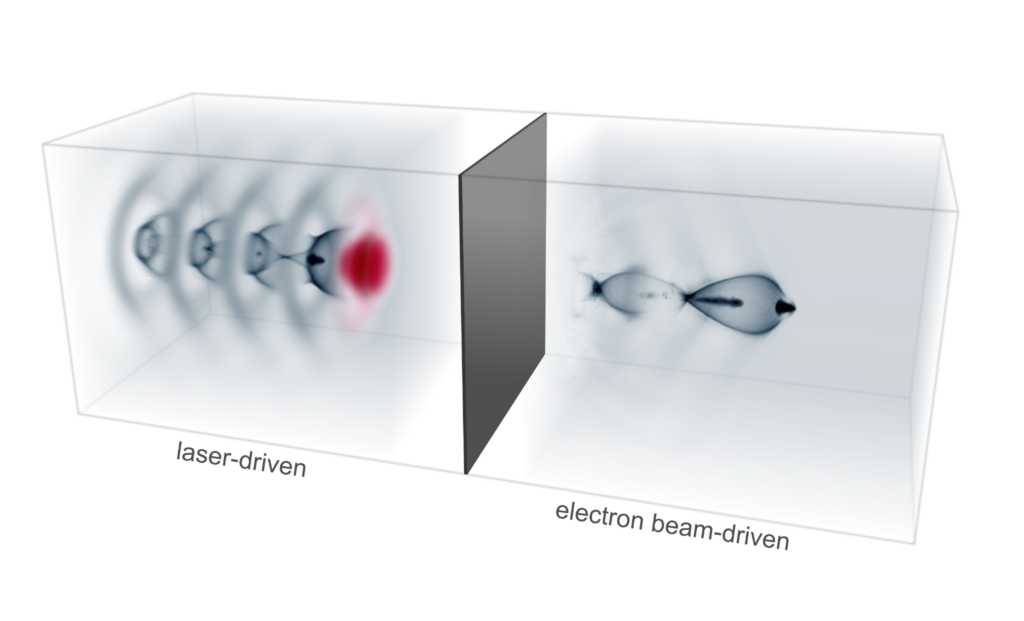Particle accelerators are behind some of the most spectacular scientific discoveries, and the reason why we know that matter consists of atoms, and that in turn atoms consist of electrons surrounding positively charged ions.
These electrons and ions are not only key building blocks of matter, but can themselves be used to realize powerful particle accelerators. By transient separation of negatively charged electrons and positively charged ions, plasma wave oscillations can be excited. In so-called laser wakefield accelerators (LWFA), the plasma wave is driven by an intense laser pulse. Electrons can be injected into these plasma waves and then ‘surf’ on the plasma waves until they become out of phase with the wave. This scenario limits the quality, and rapid energy gain, of injected electrons.
Using an intense electron beam as driver of a plasma wave, an approach known as PWFA, in contrast, generates a plasma wave which injected electrons can surf without dephasing. How to obtain such an intense electron beam driver? A concept suggested 10 years ago by the Cockcroft Institute/University of Strathclyde’s Prof. Bernhard Hidding and others, proposed to use the intense electron beam produced by LWFA, and then use this electron beam to drive a separately attached PWFA stage. This “hybrid laser-plasma wakefield accelerator” concept has in recent years been developed by a European collaboration with researchers from Strathclyde, Dresden, Munich, Hamburg and Paris.

The collaboration now reports on a milestone, the “Demonstration of a compact plasma accelerator powered by laser-accelerated electron beams”, published in Nature Communications. In two complementary experiments realized at HZDR Dresden and LMU Munich, they demonstrate the flexibility and potential of the approach. The experiments show that the electron beam generated in specially designed LWFA stages can be fed into an attached, but decoupled PWFA stage, where it drives a strong plasma wave. A plasma-injected electron beam can be post-accelerated here, and thus receives an energy boost. Such an application thus far has been possible only in a few large facilities worldwide, such as at Stanford’s 3-km long Linear Accelerator Centre SLAC. In the experiments reported in Nature Communications now, this is realized in a compact, only few-millimetres long plasma accelerator.
Thomas Heinemann, a PhD student at Strathclyde and the Cockcroft Institute and one of the two first authors of the study, says: “Our compact, hybrid plasma wakefield accelerator can serve as platform to explore and develop key plasma wakefield physics, such as energy boost, wakefield dynamics, and novel injection methods. Instead of being exclusively limited to overseas experiments at large facilities with limited beamtime and access, we can now study these issues also at home, in complementary parameter regimes.”
Prof. Bernhard Hidding adds: “One of the most intriguing aspects is the automatic synchronization of laser and electron beams. This can in next steps enable realization of compact plasma photocathodes for ultrabright electron beam production.” Such ultrabright electron beams have transformative potential for example to drive ultracompact, yet high-performance hard x-ray free-electron-lasers.
The hybrid plasma accelerator platform and applications can in the future be realized in the UK at SCAPA, the Scottish Centre for the Application of Plasma-based Accelerators and EPAC, the Extreme Photonics Applications Centre.
The UK part of the research was funded by the European Research Council through the “NeXource” project, and by STFC through the “PWFA-FEL” project and the Cockcroft Institute, and by EPSRC.
Article reference:
Demonstration of a compact plasma accelerator powered by laser-accelerated electron beams
T. Kurz, T. Heinemann, et al.
Nature Communications 12: 2895 (2021)
